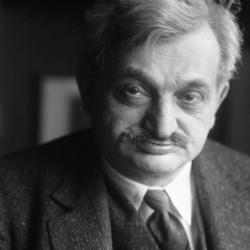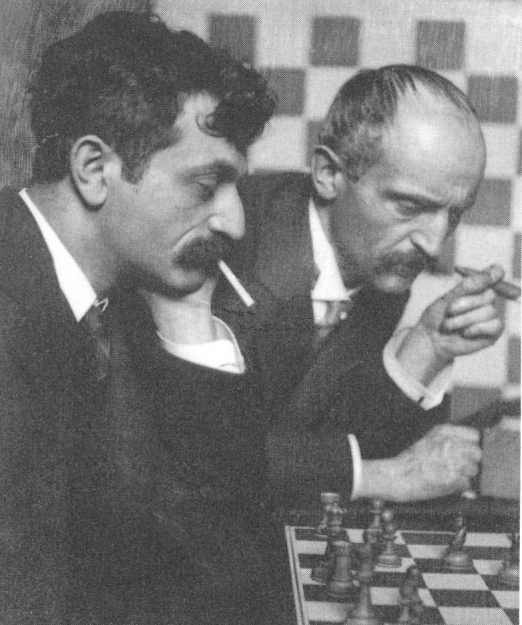Emanuel Lasker

Bio
Emanuel Lasker is considered one of the strongest players of all time. He was the second world champion, holding the title from 1894-1921. Lasker's 27 year reign is the longest in history, and he successfully defended his title five times. His playing career lasted for five decades (1880s-1930s), which is an incredible accomplishment.
- Style
- Early Life to Contender
- World Champion
- 1911 Through the 1921 World Championship
- Life After the World Championship
- Legacy
Style
Lasker's playing style was universal. He was not confined to the rules or laws of the positional school of Steinitz, instead he used a more flexible approach that was ahead of his time. Lasker could do everything well, and was adept at being an all-out attacker as well as a tenacious defender. He was able to change his style according to who he was playing. Here is a wonderful attacking game from Lasker vs Euwe (one year before Euwe would become world champion). After sacrificing his queen, Lasker's knights dominate the board in a memorable fashion:
Early Life to Contender
Lasker learned chess from his brother, Berthold, at the age of 11. He lived with Berthold (who was a top ten player in the 1890s) during his teenage years in Berlin. In 1889, Lasker rose through the chess rankings quickly by winning multiple tournaments and earning his master title.
From 1890-1893, Lasker won many matches against top players (Mieses, Bird, Blackburne, Showalter, and others). During this same time period, he played exceptionally well in tournaments. Lasker finished 2nd in an international tournament in Amsterdam, won two tournaments in London in 1892, and scored a perfect 13-0-0 record to win the 1893 New York tournament.

At this point, he challenged Tarrasch to a match. Tarrasch declined the match offer to play young Lasker, and suggested that he win some larger international tournaments instead. After Tarrasch declined his offer, Lasker sent a challenge to the reigning World Champion Steinitz.
World Champion
Steinitz accepted Lasker's challenge, and the two agreed that the match would be played in 1894. To the surprise of the chess world, Lasker convincingly defeated Steinitz with a record of 12-7 (10 wins, 5 losses, 4 draws). Upon defeating Steinitz, Lasker became the second official world champion. Here is a game example from the match where Lasker gives Steinitz (the father of positional chess) some shattered pawns, and then slowly collects them before exchanging into a winning endgame:
Many players at the time thought that Lasker winning was a fluke, or even blamed Steinitz' loss on his old age (although Steinitz was only 58). The chief complaint was that Lasker had never played Chigorin or Tarrasch in a match. Lasker put these criticisms to rest with his results over the board. He finished ahead of Steinitz and Tarrasch in the 1895 Hastings tournament, and then won an elite 4 player tournament in St. Petersburg in 1896 (ahead of Steinitz, Chigorin, and Pillsbury).
In 1896-97, Lasker and Steinitz had their second match for the world championship. The result was the same, but the score was even more lopsided. Lasker won the 1896-97 rematch by a score of 12.5-4.5 (10 wins, 2 losses, 5 draws). Lasker continued building upon his success by winning the 1899 tournament in London, and the 1900 tournament in Paris. Here is a game example of Lasker's attacking prowess from this time period:
From 1900-1904, Lasker didn't play any serious chess until the famous 1904 Cambridge Springs tournament. Lasker finished tied for second place with Janowski (behind Marshall), but ahead of Showalter, Schlechter, Chigorin, Mieses, Pillsbury, Teichmann, and others. Marshall's impressive result earned him the right to challenge Lasker.
In 1907, Lasker played Marshall for the world championship. The result was another stunning victory for Lasker, who won the match 11.5-3.5 (8 wins, 7 draws). Lasker had now amassed an incredible score of 23 wins, 7 losses, and 16 draws in world championship games.
In 1908, Lasker finally faced Tarrasch for the world championship. Tarrasch was a firm believer in the idea that chess had positional rules and laws, and that these ideas could not be broken. Unfortunately for Tarrasch, Lasker was able to defy Tarrasch's logic. Lasker again defended his title with a very favorable score of 10.5-5.5 (8 wins, 3 losses, 5 draws).

In 1909, Lasker tied for first alongside Rubinstein in the Chigorin Memorial tournament held in St. Petersburg. Later that year, Lasker would defend his title against Janowski. They played two separate matches in 1909, Lasker one the first match 8-2 (7 wins, 1 loss, 2 draws). Janowski wanted a rematch, but the results were even worse for him. Lasker won the second match 9.5-1.5 (8 wins, zero losses, 3 draws).
Up to this point in his career, Lasker was seemingly invincible in match play. His ability to play multiple styles, helped him greatly as he adapted to his opponents with great ease. It wasn't until 1910 that Lasker was ever in any trouble in a world championship match.
In 1910, Lasker played Schlechter. Schlechter had a reputation of drawing many games, which did not help him in large open tournaments but proved to be somewhat of an asset in match play. Going into the final game, Schlechter was ahead 5-4. In the final game of the 10 game match, Schlechter had a winning position. He only needed a draw to defeat Lasker, but after missing a winning blow he eventually lost. Lasker evened the score at 5-5 and retained his title.

1911 to the 1921 World Championship Match
After the 1910 match with Schlechter, it would be another 10 years before Lasker would defend his title again. In 1911, Lasker entered negotiations with Capablanca, but the two could not agree to match terms. In 1912, Lasker agreed to a match with Rubinstein (who had been on a big winning streak), but Rubinstein could not raise the necessary funds for the match. In 1914, Lasker won the historical 1914 St. Petersburg tournament. He finished ahead of future world champions Capablanca and Alekhine, as well as Tarrasch, Marshall, Nimzowitsch, Rubinstein, Janowski, Blackburne, and others.
As we have discussed before, Lasker was able to change his style at will. He would often use someone's style against them! In the final rounds of the 1914 St. Petersburg tournament, Lasker defeated Capablanca to take the lead in the tournament. Here is the famous game of Lasker using positional ideas and an endgame squeeze in order to defeat Capablanca (the king of endgames):
Unfortunately, in 1914 the start of World War I put a stop to almost all chess activities. In 1916, Lasker defeated Tarrasch by a score of 5.5-0.5 (although this wasn't an official world championship match). In 1918, he won a four-player tournament ahead of Rubinstein.
In 1920, Lasker and Capablanca agreed to terms to play the 1921 world championship match. The match was originally scheduled for 24 games or the first player to 12.5 points (the same format used by FIDE from 1951-1975). However, Lasker resigned the match after game 14. The score was heavily in Capablanca's favor 9-5 (4 losses and 10 draws).
Life After the World Championship
Lasker's 27-year reign as world champion ended after the loss to Capablanca, but Lasker would remain active in tournaments and had great success. In 1923, Lasker won the 1923 Moravska Ostrava tournament (ahead of Reti, Grunfeld, Tartakower, Euwe, Tarrasch, Bogoljubov, Spielmann, Rubinstein, and others).
In 1924, Lasker won the famous New York tournament, ahead of World Champion Capablanca, Alekhine, Marshall, Reti, Maroczy, Bogoljubov, Janowski, and others. Here is a game example from this tournament, where we see Lasker defeating future World Champion Alekhine in a messy position (the type of positions Alekhine thrived in):
Lasker's tournament success continued at the 1925 Moscow tournament, where he finished in second place behind Bogoljubov, but ahead of Capablanca, Marshall, Tarakower, Reti, Grunfeld, Rubinstein, Samisch, and others. After this tournament, Lasker took a long break from tournament chess. He would not play again until 1934 when he finished fifth in the Zurich tournament.

In 1935, Lasker finished third in the Moscow tournament at the age of 66. He was half a point behind future world champion Botvinnik and Salo Flohr, but he finished ahead of Capablanca, Levenfish, Kan, Lilienthal, Ragozin, Alatortsev, Pirc, Chekhover, and other Soviet masters. Here is Lasker's game against Capablanca from this tournament, a marathon endgame where Lasker has a queen vs Capablanca's rook and bad bishop:
Legacy
Lasker's legacy is not solely as a chess giant and world champion, but also as a chess theoretician. His contributions to the Ruy Lopez, Queen's gambit, French Defense, and Sicilian defense are still used today. Lasker was also a chess author - he published chess magazines most of his life and wrote five chess books. His life and games are still studied in books, videos, and articles.
Aside from his legendary accomplishments on the board, he was also a mathematician, philosopher, and playwright. Albert Einstein was a good friend of Lasker's and wrote the introduction to Lasker's biography. In the introduction to the book, Einstein states "Emmanuel Lasker was undoubtedly one of the most interesting people I came to know in my later years...there are few men who have had a warm interest in all the great human problems and at the same time kept their personality so uniquely independent.".
It is for all of the reasons given above, his memorable longevity at the top of the chess world, the generations of players he has inspired, and more, that Lasker will always be remembered as one of the greatest world champions of all time.



